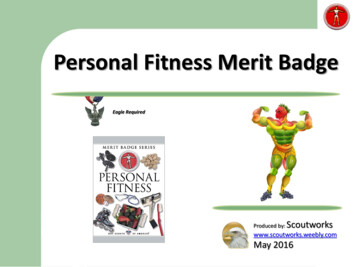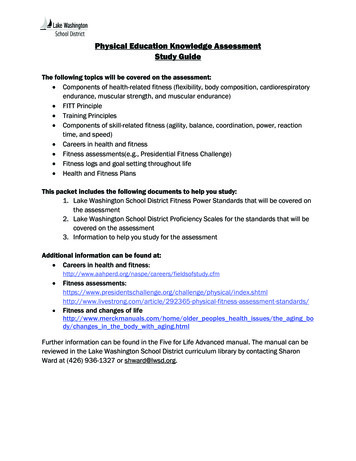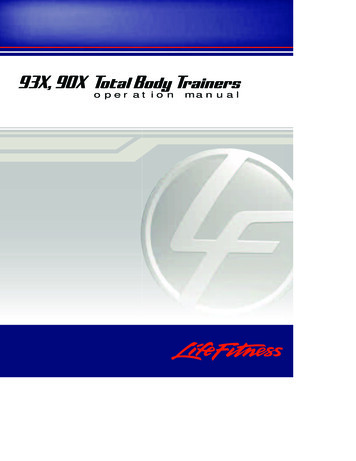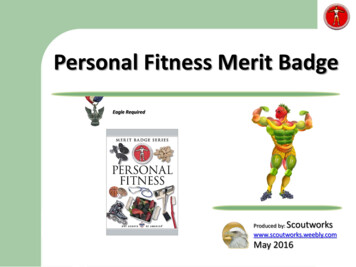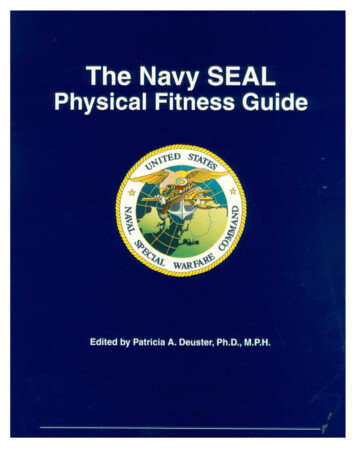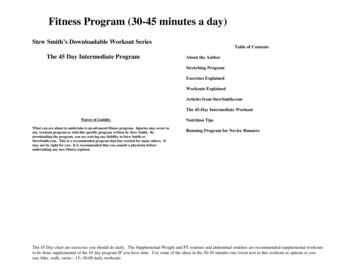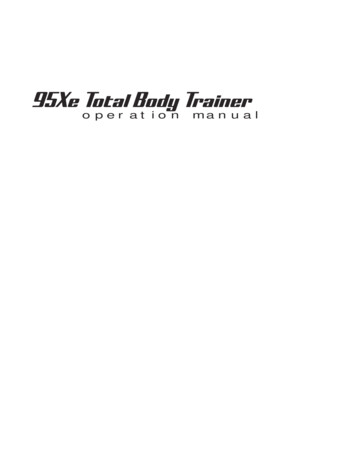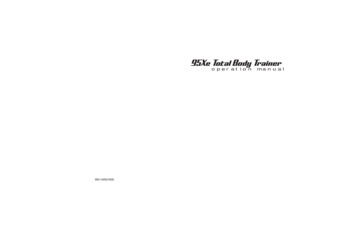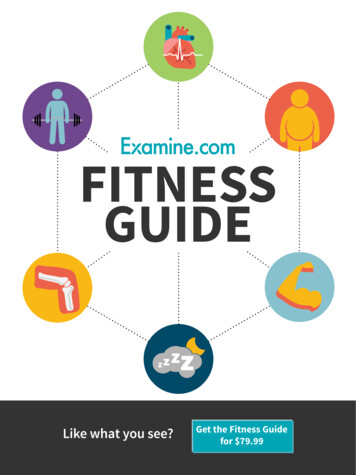
Transcription
FITNESSGUIDELike what you see?Get the Fitness Guidefor 79.99
Medical DisclaimerThis guide is a general-health document for adults 18 or over. Its aim isstrictly educational. It does not constitute medical advice. Please consult amedical or health professional before you begin any exercise-, nutrition-, orsupplementation-related program, or if you have questions about your health.This guide is based on scientific studies, but individual results do vary. If youengage in any activity or take any product mentioned herein, you do so ofyour own free will, and you knowingly and voluntarily accept the risks. Whilewe mention major known interactions, it is possible for any supplement tointeract with other supplements, with foods and pharmaceuticals, and withparticular health conditions.For more information on the supplements mentioned in this guide, pleasevisit Examine.com.2
Table of Contents02060917Medical DisclaimerForewordWhat Does It Mean to Be Fit?How to Use This GuidePART I: MUSCLE GAIN & EXERCISE PERFORMANCE1925363943IntroductionCore SupplementsPrimary OptionsSecondary OptionsInadvisable SupplementsPART II: FAT LOSS4655576370IntroductionCore SupplementsPrimary OptionsSecondary OptionsInadvisable SupplementsPART III: TESTOSTERONE748286888990IntroductionCore SupplementsPrimary OptionsSecondary OptionsPromising SupplementsInadvisable SupplementsPART IV: CARDIOVASCULAR HEALTH92 Introduction98 Core Supplements104 Primary Options111 Secondary Options114 Promising Supplements115 Inadvisable SupplementsPART V: JOINT HEALTH117124125132134IntroductionCore SupplementsPrimary OptionsSecondary OptionsInadvisable SupplementsPART VI: SLEEP136144147149152IntroductionCore SupplementsPrimary OptionsSecondary OptionsInadvisable SupplementsCOMBOS154155157162167IntroductionCore ComboSpecialized CombosFAQPrecautions and TroubleshootingDIETING169178187206214215The Psychology of DietingDieting for Fat LossDieting FAQMovement and Body PositioningAfterwordRecommended Reading3
ForewordWelcome to The Examine.com Fitness Guide: A blueprint for optimizingnutrition and supplementation.Kamal here. You likely know me as the cofounder of Examine.com. I wantto take a moment to introduce you to the other cofounder, Sol Orwell. Justlike you, Sol and I are constantly striving to raise our fitness levels; that’s whatdrove us to create Examine.com in the first place.During those hours when the Examine.com team is knee-deep in researchlogistics, practical questions of fitness keep coming up — but not along thelines of “Are eight reps better than twelve?” or “30 grams of protein four timesa day, or 40 grams of protein three times a day?”Rather, we’re always thinking about the big picture of fitness. And the bigpicture isn’t shaped by minute differences in exercise volume or proteinintake, but rather by a variety of bottlenecks. By eliminating commonstumbling blocks, you can optimize your results.Figure 1: Roadblocks to optimal fitness11% of Americans sufferfrom chronic pain.78% of Americans don’t meetthe national exercise guidelines.Joint pain is the mainreason regular gymgoers stop exercising.Sleep is neededfor tissue healing,mental health,and a lot more.Strength andendurance are thehallmarks of a fit body.Roadblocksto optimalfitnessExercise capacityis dependent ona healthy heart.35% of Americans reportsleeping too little.46% of American adultshave high blood pressure.Testosterone affectseverything, from muscleand bone mass to mood.40% of American men over age45 have low testosterone.Excess fat makes the heartwork harder and adverselyaffects hormones.70% of American adultsare overweight or obese.6
ForewordThese six categories come together to form the backbone of fitness. Andeach is explored here, in detail, in this Fitness Guide.But to understand the importance of these categories, numbers only go so far.So let’s use a couple of examples: Sol and me.Sol lost over 60 pounds of fat,massively improving his healthand his overall fitness; he did itnot with crazy diets or magicpills but with scientific evidence.Spreading the gospel of rationalnutrition approaches becamehis calling.At the start of his journey, Solmet me; I had lost 50 pounds ofmuscle due to the chronic paincaused by a genetic disordercalled Ehlers-Danlos syndrome.Small world — it turned out Solhad the same condition!Photo: Martin DonnellyPhoto: Aous PoulesPeople often associate gains in the gym to tweaks in workout routine ortechnique. The truth is, though, that problems like joint pain and sleep issueshave a much larger impact on your ability to consistently exercise and increaseyour fitness. Unfortunately, as people get older, fat gain, muscle loss, andtestosterone decline can seem inevitable.That’s why we wanted to write, first of all for ourselves, a no-nonsense fitnessguide — a guide that covered the big picture, not just one facet of fitness.We’ve felt the impacts of all the multiple factors contributing to optimalfitness. We’ve seen the same in family and friends. We know that fitness ismore than just building muscle. It will only take you a few seconds to think ofyour own family and friends, and of which bottlenecks might be getting in theway of their own fitness and health.This guide is about empowering yourself. For each of the above categories,we first lay out the big picture, then we get into which supplements might7
Forewordhelp you out, which are promising but still under-researched, and which are awaste of time and money. Our sincere hope is that you’ll pour over what we’vewritten, and use it to make yourself happier by being healthier and fitter.We’ll now hand over the mic to the researchers and experts who worked onthis guide. Best of luck!Kamal Patel, CofounderMBA, MPH, PhD(c) in NutritionSol Orwell, CofounderHow do all the various aspects of health fit together, given the thousandsof papers published each year? Answering that question is both Kamal’sfavorite hobby and his job as cofounder and director of Examine.com.He’s published peer-reviewed studies on a variety of topics, from vitaminD and cardiovascular risk to fructose and liver health. Kamal’s views onresearch (and life) can be summarized by Maimonides’s timeless saying:“Teach thy tongue to say ‘I do not know,’ and thou shalt progress.”Profiled in Entrepreneur, Forbes, Inc., Men’s Fitness, and Men’s Health, andan advisor to Arnold Schwarzenegger, Sol Orwell is an entrepreneur witha knack for solving problems that frustrate others. He has been buildingbusinesses since 1999 and is even now working to extend to other industriesExamine.com’s approach of nuance and non-sensationalism. In his sparetime he eats copious amounts of cookies and hosts charity food-offs.8
PART VI:SLEEP135
IntroductionNearly twenty years ago, as a young pup researching weightlifting out of mydorm room, I suddenly reached my limit. I thought I knew everything aboutweights and nutrition (ha!) and it was time to move on to the next topic: sleepscience. So I bought an accelerometer-equipped sleep watch on this cool newsite called “eBay”.Oh my. I was a mild data junkie before then, but the watch turned me into alevel 10 junkie. When I got even a bit less sleep, it was highly correlated withlower test scores, more stress, and gym plateaus! Sleep seemed to be moreinfluential than how much protein I got, what my lifting routine was, andpretty much anything else.Digging Deeper: Sleep tracking? There’s an app for thatIn the late 1990s, accelerometer-equipped watches became available for sleeptracking. They weren’t used for clinical sleep assessment — for which dedicatedhome devices,1 clunkier but more accurate, had recently become available tophysicians — but they did provide the curious layman with some sleep data.Fast-forward a couple decades, and now anyone with a smartphone can use itsaccelerometer to track sleep, using cheap or free apps. But are these apps accurate?Can they really tell you how much time you spend in the different stages of sleep,2 orhow efficient your sleep was? Well, according to a recent study no, not really.3Still, those apps might bring to your attention potential problems (e.g., if you learnthat you get up at the same time every night, you can try to understand why). Theymay also, very simply, keep you invested in maintaining healthy sleep patterns.There is anecdotal evidence that a smartphone will track your sleep more accurately if youstrap it to your arm or leg rather than lay it on your bed (especially if your bed is of the memoryfoam variety). But if you want better, you can purchase a fitness device. Not all such deviceswill be equally accurate, however, and any study on a given device is likely to have beenfunded by the device’s manufacturer.4 (Industry funding does not disqualify a study, but anindustry-funded study is less likely to get published if it doesn’t produce favorable results.)136
Part VI: Sleep — IntroductionThe problemLack of sleep can negatively affect every aspect of your life, and fitness is noexception. Lack of sleep impairs athletic performance, in both the short term5 andthe long term, and it does so in several ways, some more obvious than others: Impaired focus.6 You simply can’t give your all if you’re not really “there”when you train. Impaired skill acquisition. Your ability to build specific brain-muscleconnections (let’s say, to throw a ball accurately) decreases with sleepdeprivation, possibly due to a decrease in myelin production.7 Moreover,to build the right brain-muscle connections, you need to repeat the rightmoves, which becomes harder with impaired focus. Impaired insulin signaling and thus impaired glucose metabolism.8Glucose, also known as blood sugar, is a main source of energy; ifyou cannot burn this fuel efficiently, you’ll gas out sooner (and riskdeveloping diabetes,9 to boot). Increased inflammation10 and thus increased risk of injury. Moreover, even lowlevel pain11 fosters fatigue (you’ll gas out even sooner) and further impairs focus. Impaired cardiovascular health. If you don’t get enough sleep, you’re ata higher risk for cardiovascular disease.12 Impaired glucose metabolism isone of the probable causes. Impaired muscle gain. You’ve probably heard that “you grow whenyou sleep”. In truth, we’re still not quite sure that more muscle is builtduring sleep than during waking hours; but we do know that lack of sleepimpairs muscle gain.13 The reasons are complex; they include a decrease intestosterone production14 and, as we saw, an increase in fatigue (if you can’texercise as hard, or as long, you limit your potential for muscle growth).Wow. Is that all, now? Not quite. Because in addition to a decrease in athleticperformance per se, lack of sleep also causes an increase in fat gain. And isn’tthat unfair? If you spend more time awake, shouldn’t you burn more calories?And isn’t burning more calories what fat burning is all about? So why doesstudy after study show that you gain fat as you lose sleep?15The main reason is simple: as you sleep less, you eat more. Even partial sleepdeprivation can cause a 20% increase in voluntary energy intake.16 It alsocauses your body to burn less fat and more muscle (which is yet anotherreason why lack of sleep impairs muscle growth).17137
Part VI: Sleep — IntroductionNow I hope all this bad news won’t keep you awake at night, or I’ve justbecome part of the problem! Because there are two big reasons people don’tget enough sleep, and stress is one of them. The other big reason is thatmany people simply don’t schedule enough time for sleep on a daily basis,instead hoping to “catch up” during the weekend (a strategy with very limitedefficacy). Other reasons, less widespread but harder to address, include pain,18sleep apnea, and the forms of insomnia not related to stress.The solutionsSo what can you do about it? Let’s be blunt: all a supplement can do is helpyou fall asleep, help you stay asleep, and help you sleep better. No supplementis going to knock you out, and of course, no supplement will pack eight hoursof sleep into five hours.If you want your sleep to improve, you’ll have to work with your supplements,not against them. You won’t like it, but here it is: First, you need to scheduleenough time for sleep each day. Second, you should try going to bed at thesame time every day, even during the weekend, as this habit both improvessleep quality and reduces the time it takes to fall asleep. Third, for at least onehour before bed, you need to relax and avoid sources of blue light.Blue light (produced by most screens as well as by the sun) can keep you awakeeven after you turn it off; and even after you fall asleep, it can still reduce yourbody’s production of melatonin, thus decreasing the quality of your sleep.Because playing games and answering emails tend to stimulate your brain,those activities are less than ideal near bedtime. Still, if you really need touse your phone, tablet, or computer at night, consider using a program thatreddens your screen light after sunset. Or, if you cannot easily adjust the colorbalance of your screen, start wearing blue-light-blocking glasses a couple ofhours before bedtime.138
Part VI: Sleep — IntroductionTip: What should you avoid doing before bed?If you ask people what they’d like to do before bed, you might hear answers such as meditate,read a book, or share some special time with their partner. But in reality, texting, playing games,or working is becoming more prevalent by the year, to the probable detriment of sleep quality.19Aside from fiendishly typing and checking social media, are there any otheractivities you should avoid in order to get a sound night’s sleep?Eating right before bed is often targeted as a sleep killer. But the evidence is morenuanced; in some people, consuming small amounts of food, such as a glass of milk ora small snack, can benefit sleep.20 Nighttime exercise is another frowned-upon activity,yet recent trial21 and survey22 evidence has shown a potential benefit on sleep.As it stands, more than what your pre-bed activities are, what’s likely to hurt your sleepat that time is excess light exposure. The bright lights of a gym will have this effect, but sowill using a tablet — a light-emitting device — rather than reading a printed book.23Figure 2: Effect of light on melatonin productionFigure 1: Effect of light on melatonin production60Serum melatonin (pg/ml)504030dim light20bright light throughblue-light-blockingglasses10bright light0891011121p.m.2345678a.m.Source: Kayumov et al. J Clin Endocrinol Metab. 2005 MayAll set? Then, after the eyes, the ears. Noise can both reduce sleep qualityand make it harder to fall asleep,24 so minimize the noise in your bedroom.If that doesn’t suffice, get earplugs, but keep in mind that earplugs attenuatehigh frequencies more than they do low frequencies — they may protect youagainst cars honking, but not much against traffic rumble.Noise is bad enough, but heat can be worse.25 A bedroom warm enough to raiseyour core temperature can impair sleep quality and even cause insomnia.26139
Part VI: Sleep — IntroductionConversely, a bedroom cool enough to lower your core temperature (but notso chilly as to be uncomfortable) will help you fall asleep faster and enterthe deeper stages of sleep sooner.27 An instinctive desire to reduce one’s coretemperature also explains why some people like to keep a foot outside theircover (hands and feet being especially good at dissipating body heat).There you have it. If anything, supplementation should be considered asolution of last resort, reserved for people who cannot sufficiently improvetheir sleep through lifestyle changes. And even if you do need them, do notfeel you have to take supplements daily: if their efficacy seems to wane asweeks go by, try taking them only three to five nights a week.It may take you a couple of months to determine your optimal combinationof supplements, and a couple more to ascertain your best supplementationschedule. Every few months afterward, consider pausing supplementation todetermine if non-supplemented sleep quality has improved.Kamal Patel, CofounderMBA, MPH, PhD(c) in NutritionKamal Patel is cofounder and director of Examine.com. He holds twomaster’s degrees from the Johns Hopkins University, in business andin public health, and is on hiatus from a PhD in Nutrition for which he’sinvestigated the link between diet and chronic pain. He’s published peerreviewed articles on vitamin D and calcium, as well as on a variety of clinicalresearch topics. He’s also been involved in research on fructose and liverhealth, on nutrition in low income areas, and on mindfulness meditation.140
Part VI: Sleep — ReferencesReferences1Su et al. “A comparison of polysomnography and a portable home sleep study inthe diagnosis of obstructive sleep apnea syndrome” (2004)2Shrivastava et al. “How to interpret the results of a sleep study” (2014)3Bhat et al. “Is there a clinical role for smartphone sleep apps? Comparison ofsleep-cycle detection by a smartphone application to polysomnography” (2015)4De Zambotti et al. “A validation study of Fitbit Charge 2 compared withpolysomnography in adults” (2018)5Mah et al. “The effects of sleep extension on the athletic performance ofcollegiate basketball players” (2011)VanHelder and Radomsk. “Sleep deprivation and the effect on exerciseperformance” (1989)6Alhola and Polo-Kantola. “Sleep deprivation: Impact on cognitive performance”(2007)7Bellesi et al. “Effects of sleep and wake on oligodendrocytes and their precursors”(2013)8Broussard et al. “Impaired insulin signaling in human adipocytes afterexperimental sleep restriction: a randomized, crossover study” (2012)Buxton et al. “Sleep restriction for 1 week reduces insulin sensitivity in healthymen” (2010)Donga et al. “A single night of partial sleep deprivation induces insulin resistancein multiple metabolic pathways in healthy subjects” (2010)Bosy-Westphal et al. “Influence of partial sleep deprivation on energy balanceand insulin sensitivity in healthy women” (2008)VanHelder and Radomsk. “Sleep deprivation and the effect on exerciseperformance” (1989)9Cappuccio et al. “Quantity and quality of sleep and incidence of type 2 diabetes:a systematic review and meta-analysis” (2010)Chaput et al. “Sleep duration as a risk factor for the development of type 2 diabetesor impaired glucose tolerance: analyses of the Quebec Family Study” (2009)141
Part VI: Sleep — ReferencesBeihl et al. “Sleep duration as a risk factor for incident type 2 diabetes in amultiethnic cohort” (2009)10Mullington et al. “Sleep loss and inflammation” (2010)Simpson and Dinges. “Sleep and inflammation” (2007)11Haack et al. “Elevated inflammatory markers in response to prolonged sleeprestriction are associated with increased pain experience in healthy volunteers”(2007)12Michiaki et al. “Sleep duration as a risk factor for cardiovascular disease — areview of the recent literature” (2010)13VanHelder and Radomsk. “Sleep deprivation and the effect on exerciseperformance” (1989)14Cote et al. “Sleep deprivation lowers reactive aggression and testosterone inmen” (2013)Leproult and Van Cauter. “Effect of 1 week of sleep restriction on testosteronelevels in young healthy men” (2011)Penev. “Association between sleep and morning testosterone levels in older men”(2007)González-Santos et al. “Sleep deprivation and adaptive hormonal responses ofhealthy men” (1989)Cortés-Gallegos et al. “Sleep deprivation reduces circulating androgens inhealthy men” (1983)15Nedeltcheva et al. “Insufficient sleep undermines dietary efforts to reduceadiposity” (2010)16Bosy-Westphal et al. “Influence of partial sleep deprivation on energy balanceand insulin sensitivity in healthy women” (2008)17Nedeltcheva et al. “Insufficient sleep undermines dietary efforts to reduceadiposity” (2010)18Sasaki et al. “Nocturnal knee pain increases with the severity of kneeosteoarthritis, disturbing patient sleep quality” (2014)142
Part VI: Sleep — ReferencesBlay et al. “Chronic painful physical conditions, disturbed sleep and psychiatricmorbidity: results from an elderly survey” (2007)19Whipps et al. “Evaluation of Nighttime Media Use and Sleep Patterns in Firstsemester College Students” (2018)20Kinsey and Ormsbee. “The health impact of nighttime eating: old and newperspectives” (2015)21Flausino et al. “Physical exercise performed before bedtime improves the sleeppattern of healthy young good sleepers” (2011)22Buman et al. “Does nighttime exercise really disturb sleep? Results from the2013 National Sleep Foundation Sleep in America Poll” (2014)23Grønli et al. “Reading from an iPad or from a book in bed: the impact on humansleep. A randomized controlled crossover trial” (2016)Chang et al. “Evening use of light-emitting eReaders negatively affects sleep,circadian timing, and next-morning alertness” (2014)24Basner et al. “ICBEN review of research on the biological effects of noise 2011–2014” (2015)Halperin. “Environmental noise and sleep disturbances: a threat to health?”(2014)Hume et al. “Effects of environmental noise on sleep” (2012)25Libert et al. “Relative and combined effects of heat and noise exposure on sleepin humans” (1991)26Lack et al. “The relationship between insomnia and body temperatures” (2008)27Murphy and Campbell. “Nighttime drop in body temperature: a physiologicaltrigger for sleep onset?” (1997)143
Core SupplementsCore supplements have the best safety-efficacy profile. When usedresponsibly, they are the supplements most likely to help and not causeside effects.MagnesiumWhy it’s a core supplementMagnesium (Mg) is a dietary mineral that plays an important role in thebrain. A deficiency can result in abnormal neuronal excitations leading toimpaired sleep. Magnesium is lost through sweat, so deficiencies are morecommon in athletes, but they are not unknown in the general population.Magnesium is usually safe, but it may impair the absorption of somepharmaceuticals, notably bisphosphonates. Magnesium acts synergisticallywith calcium channel blockers to lower blood pressure, creating a risk ofhypotension (i.e., low blood pressure). If you take any medication, talk toyour doctor before you consider supplementing magnesium.How to take itA diet comprising magnesium-rich foods (such as fish, nuts, beans, andgreen leafy vegetables) renders supplementation unnecessary, at least forthe purpose of improving sleep. In case of magnesium deficiency, adding orincreasing dietary sources of magnesium should be the first option, but in theabsence of practical ways of doing so, supplementation can be used.144
Part VI: Sleep — Core SupplementsMilligrams of magnesium per 3.5 oz ( 99 g) of foodFigure1: MagnesiumContent(mg) of Seedsand NutsFigure2: Magnesiumcontentof seedsand zil NutsSesameSeedsChia SeedsCashewNutsAlmondsPine NutsLow dietary magnesium can impact sleep quality. Nuts and seeds are a great source of magnesium.Incorporating some of the above foods into your diet can help ensure sufficient magnesium intake.Commonly supplemented forms include citrate, gluconate, and glycinate. Toincrease absorption, magnesium gluconate should be taken with a meal; otherforms can also be taken on an empty stomach. Magnesium oxide is better avoided:it has low bioavailability, which can cause intestinal discomfort and diarrhea.The standard dose is 200 mg of elemental magnesium once a day, though upto 350 mg can be used. Because magnesium might have a sedative effect, it isoften supplemented before bed.Avoid taking magnesium, calcium, iron, and zinc at the same time incombinations of 800 mg, since high amounts of these minerals will competefor absorption. Magnesium may also impair the absorption of antibiotics,notably those in the tetracycline class (e.g., doxycycline) and quinolone class(e.g., ciprofloxacin), so take magnesium and antibiotics at least six hours apart.MelatoninWhy it’s a core supplementMelatonin is a hormone involved in the circadian rhythm (which dictatessleeping and waking cycles). As you wake up in the morning, melatonin levels godown, while at night, or if you dim the lights, melatonin production increases.145
Part VI: Sleep — Core SupplementsFigure 3: Natural melatonin variations throughout the dayFigure 2: Natural Melatonin Variations Throughout the Day6 a.m.9 a.m.12 p.m.3 p.m.6 p.m.9 p.m.12 a.m.3 a.m.6 a.m.9 a.m.Melatonin’s benefits hinge on its ability to decrease the time it takes to fallasleep. If you fall asleep easily, you do not need to supplement melatonin.Your body can make melatonin out of the amino acid L-tryptophan, but sincesupplemental melatonin is inexpensive, readily bioavailable, and more reliablethan tryptophan, there is no reason to include tryptophan in your sleep stack.How to take itTake 0.5 mg (500 mcg) half an hour before bed. Increase by 0.5 mg eachweek until you find the lowest effective dose that works. Do not take morethan 5 mg. Time-release melatonin may be more effective at sustaining sleepthroughout the night.146
Primary OptionsPrimary options may provide substantial benefit, but only in the rightcontext. A primary option is not for everyone, but if you read the entryand find that you meet the criteria, consider adding the supplement toyour combo.LavenderWhy it’s a primary optionLavender (Lavandula) is traditionally used in aromatherapy for its relaxingscent. Because of the difficulty of blinding aromatherapy studies, a lot of theevidence for lavender’s effects stems from lower-quality studies, but newerstudies have examined oral supplementation to treat anxiety.Intrusive thoughts can increase the time it takes to fall asleep; lavender canease anxiety and reduce those intrusive thoughts. Lavender can also improvessleep quality, though more research is needed to determine the mechanismbehind this effect. Likewise, more research is needed to confirm if lavenderand lemon balm are indeed synergistic.Because anxiety is prevalent in younger women, anxiety treatments are oftentaken along with contraceptive pills. One study has shown that lavenderdoesn’t interact with a type of estrogen-based birth control: ethinyl estradiolwith levonorgestrel.Yet lavender may have hormonal effects. The Endocrine Society and the NationalInstitutes of Health warn that there is mechanistic and anecdotal evidence that lavenderoil has estrogenic properties and can cause gynecomastia (enlarged breasts in males).It is reassuring that none of the clinical trials have reported gynecomastia among theirsubjects, but still, if you are male and your breasts becomes tender, stop using lavender.How to take itTake 80 mg of Silexan, a lavender oil preparation standardized for the activecomponent linalool at 25–46% of total weight, 30–45 minutes before bed.After two weeks, if no benefit has been observed, the dose can be increased to160 mg (this is the maximum dose).147
Part VI: Sleep — Primary OptionsLavender oil is also used in aromatherapy — burned as a candle, heated,placed in a vaporizer, or added to a hot bath. The number of variables (productconcentration, proximity of the user to the source, size of the room ) makesrecommending dosages exceedingly difficult, but studies have used at least 30minutes of exposure in a well-ventilated room either at night or in the afternoon.148
Secondary OptionsSecondary options have less evidence for their effects. They could workor be a waste of money. Keep them in mind, but think twice beforeadding them to your combo.GlycineWhy it’s a secondary optionStudies on glycine have not found supplementation to improve sleep qualityor reduce the amount of time it takes to fall asleep, but participants reportedfeeling significantly more rested the following morning.Figure 3: Effects of Glycine on Subjective Sleep QualityFigure 4: Effects of glycine on subjective sleep qualityHow satisfied were youwith last night’s sleep?SatisfiedUnsatisfied4How much difficulty did you havein falling asleep last night?Difficult3322110EasyPlacebo0GlyHow long did it take youto fall asleep last night?PlaceboGlySubjective sleep efficiency(percentage of time spent in bed PlaceboGlyWhile some studies have shown improvements on the perception of sleep qualitywith glycine supplementation, those studies have all been short term.Source: Yamadera et al. Sleep and Biological Rhythms. 2007.149
Part VI: Sleep — Secondary OptionsThough glycine does not provide the health benefits that result fromimproved sleep quality, the perception of having had a good night’s sleepmakes for a comfortable and energetic morning. Plus, glycine is cheap andsafe, making it a viable supplement option.However, studies on glycine have all been short term (four days or less), andanecdotal reports suggest that benefits wear off. Therefore, glycine is probablybest used intermittently.How to take itTake 3 g of glycine 30–60 minutes before sleep. Glycine is usually taken withfood, but further research is needed to determine how important mealtimesupplementation really is. If eating too close to bedtime disrupts your sleep,take glycine on an empty stomach instead.Glycine can be purchased as pills but is cheaper as bulk powder, which shouldbe mixed with water and tastes rather sweet.Lemon BalmWhy it’s a secondary optionLemon balm (Melissa officinalis) is a light sedative. Like lavender, with whichit may be synergistic, lemon balm can reduce the time it takes to fall asleep.Unlike benzodiazepines, lemon balm is not potent enough to have addictiveor habit-forming properties. Nevertheless, any supplement with a sedativeeffect can disrupt working memory and reduce attention span. Do not driveor operate heavy machinery after taking lemon balm or any other supplementwith a sedative effect. Do not take lemon balm during the day.How to take itTake 300–1,200 mg of lemon balm 30–60 minutes before bed. Start with 300 mg;ramp up to 600 mg over the course of a we
nutrition approaches became his calling. At the start of his journey, Sol met me; I had lost 50 pounds of muscle due to the chronic pain caused by a genetic disorder called Ehlers-Danlos syndrome. Small world — it turned out Sol had the same condition! People often associate ga
